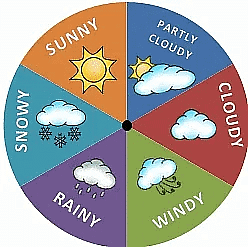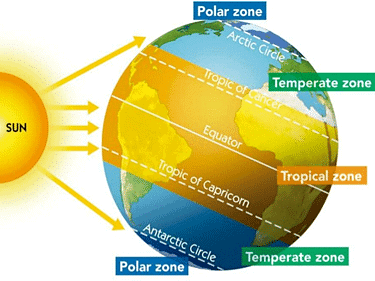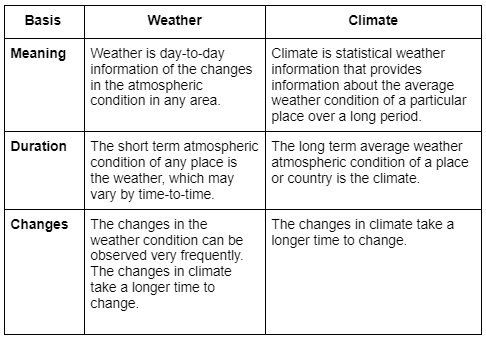Weather and Climate - 1 Class 5 Worksheet SST
Q1: Multiple Choice Questions (MCQs)
(i) The condition of the atmosphere at a given place and time is called
(a) season
(b) altitude
(c) climate
(d) weather
Ans: (d)
Weather is the state of the atmosphere at a particular place during a short period of time. It involves such atmospheric phenomena as temperature, humidity, precipitation (type and amount), air pressure, wind, and cloud cover.
(ii) The Sun’s rays fall directly on the areas near the
(a) North Pole
(b) South Pole
(c) Equator
(d) Antarctic Circle
Ans: (c)
The Sun’s rays fall directly on the Equator because it is the widest part of the Earth, positioned halfway between the North and South Poles. This direct sunlight makes equatorial regions warmer and results in consistent day lengths throughout the year.
(iii) The water vapour or moisture present in the air is called
(a) rain
(b) cloud
(c) humidity
(d) dew
Ans: (c)
The amount of water vapour in the air is called humidity. The amount of water vapor in the air as compared with the amount of water that the air could hold is called humidity.
(iv) It is hot and humid throughout the year in the
(a) Temperate Zone
(b) Torrid Zone
(c) Frigid Zone
(d) mountains
Ans: (b)
The Torrid Zone (also called the Tropical Zone) lies between the Tropic of Cancer and the Tropic of Capricorn. Here the sun’s rays fall vertically, making the region hot, and high evaporation along with rainfall makes it humid throughout the year.

Q2: Fill in the blanks
(i) The__________of a place does not change over a long period of time.
Ans: The climate of a place does not change over a long period of time.
(ii) The rays of the Sun become__________as one moves away from the Equator.
Ans: The rays of the Sun become slanting as one moves away from the Equator.
(iii) The__________Zones remain cold all year round.
Ans: The Frigid Zones remain cold all year round.
(iv) The world is divided into__________major climatic regions.
Ans: The world is divided into five major climatic regions.
(v) Places near the coast have a__________climate.
Ans: Places near the coast have a moderate climate.
EduRev Tips:
- Climate refers to the average weather conditions (like temperature and rainfall) of a region observed over many years, while weather describes the day-to-day conditions.
- The sun rays fall almost straight at the equator while they fall slanting as we move away from the equator towards the poles.
- Frigid zones, located near the North and South Poles, are characterized by extremely low temperatures, with ice and snow covering the land for most of the year.
- World climates are generally divided into five large regions: tropical, dry, mid-latitude, high latitude, and highland.
- Coastal areas have a moderate climate because oceans and seas absorb heat and keep temperatures steady, making summers cooler and winters warmer.

Q3: Answer these questions.
(i) Why do places near the Equator receive more heat than those near the poles?
Ans: The places near the Equator receive more heat than those near the poles because the equator is closer to the sun. The sun's energy is more spread out at the equator. The sun's rays hit the Earth's surface at a higher angle at the equator.
(ii) Why does Chennai have a moderate climate?
Ans: Even though Chennai is in the Torrid Zone and close to the equator, its climate remains moderate due to the influence of coastal breezes and seasonal rainfall.
(iii) Describe the climatic conditions of each heat zone.
Ans: Heat zones are the different zones of the Earth, where the sun's rays fall differently, thus causing different climate patterns. These zones are called the Torrid Zone, the two Temperate Zones, and the two Frigid Zones.
1. The Torrid Zone is very hot since the sun shines overhead here.
2. The Temperate Zones maintain a moderate climate.
3. The Frigid Zones are extremely cold.
(iv) Write the difference between
(a) weather and climate.
Ans:

(b) moderate climate and extreme climate.
Ans:
- In a moderate climate, it is neither too hot in summer nor too cold in winter. In extreme climates, the summers are too hot and the winters are too cold.
- The annual and average range of temperature is low in moderate climates and higher in extreme climates.
- Moderate temperatures are generally found in coastal areas, whereas extreme temperatures are generally found in inland areas.
- An example of a moderate-temperature city is Chennai, and that of an extreme-climate city is Delhi.
(v) How do winds influence the climate of a place?
Ans: The winds affect the climate because they create the way hot and cold air is moved around. Wind currents can push warm or cold air in the direction of the currents. They can even push storms in the direction the current is flowing. The wind movement also influences the climate of a particular place.
Q4: Think and answer
(i) Shimla and Ludhiana are almost at the same distance from the Equator. Then, why is Shimla much colder than Ludhiana?
Ans: Shimla and Ludhiana are almost at the same distance from the Equator, but Shimla is located at a much higher altitude than Ludhiana. The places located at higher altitudes are much colder than those at lower altitudes. That is why Shimla is colder than Ludhiana.
|
33 videos|264 docs|50 tests
|
FAQs on Weather and Climate - 1 Class 5 Worksheet SST
| 1. What is the difference between weather and climate? |  |
| 2. How do weather forecasts help us? |  |
| 3. What are the main factors that influence climate? |  |
| 4. Why is it important to study weather and climate? |  |
| 5. What are some examples of extreme weather events? |  |






















